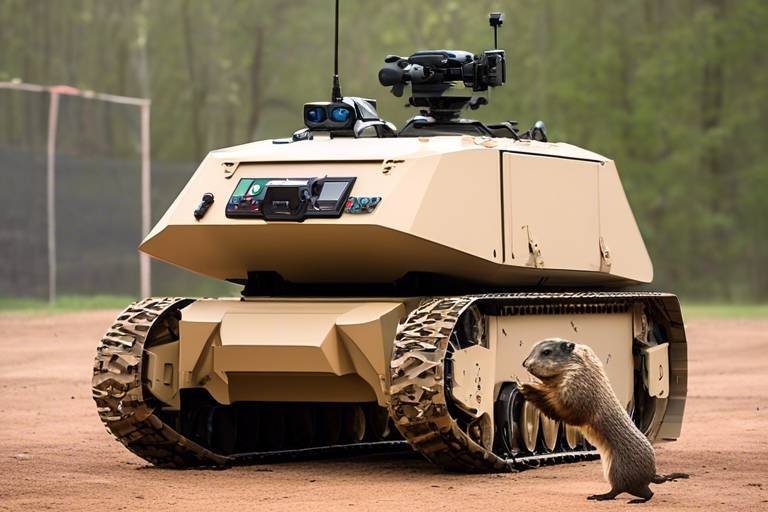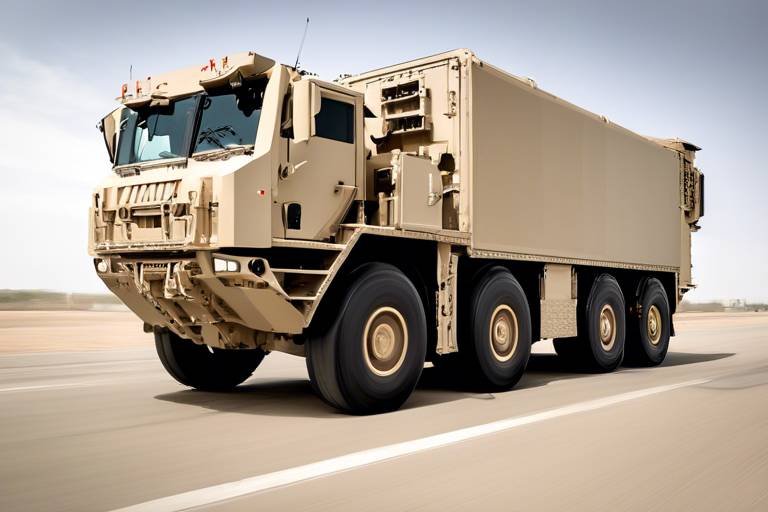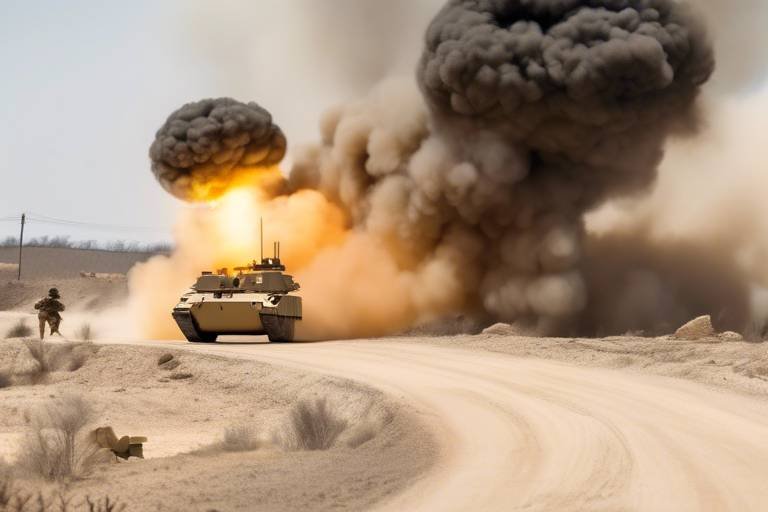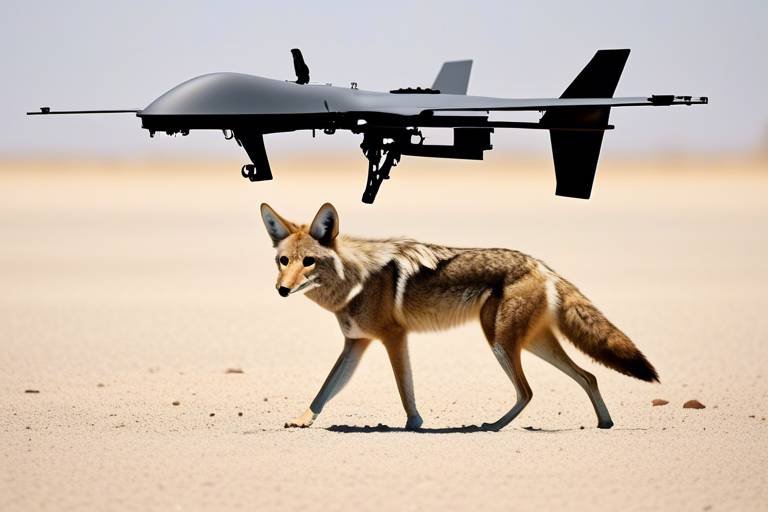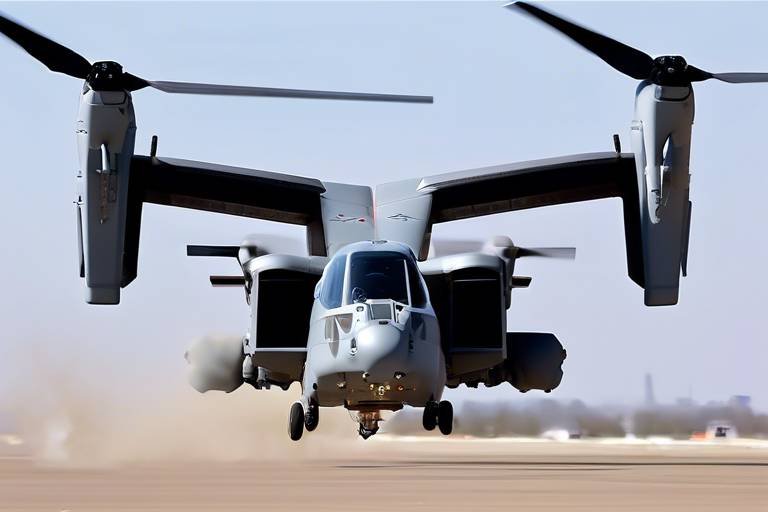Current Trends in Autonomous Systems for Reconnaissance Missions
The landscape of reconnaissance missions is undergoing a dramatic transformation, thanks to the rapid advancements in autonomous systems. These systems are not just a futuristic concept; they are becoming integral to both military and civilian operations, enhancing the way we gather intelligence and respond to threats. Imagine a world where drones equipped with advanced technologies can fly over hostile territories, gather critical data, and return without any human intervention. This is the reality we are stepping into, and it’s nothing short of revolutionary.
At the heart of these advancements lies a blend of cutting-edge technologies, including artificial intelligence, machine learning, and innovative sensor technologies. These elements work in harmony to create systems that are not only autonomous but also remarkably intelligent. They can analyze vast amounts of data, recognize patterns, and make real-time decisions, which are essential for mission success. As we delve deeper into the capabilities and applications of these systems, it becomes clear that they are reshaping the future of reconnaissance missions.
Furthermore, the implications of these technologies extend beyond traditional military operations. In civilian applications, autonomous reconnaissance systems are being utilized for disaster management, environmental monitoring, and search-and-rescue missions. This versatility illustrates how these innovations can benefit society at large, providing crucial support in times of need. However, with great power comes great responsibility, and it is vital to navigate the regulatory and ethical challenges that accompany the deployment of such systems.
As we explore the current trends in autonomous systems for reconnaissance missions, it is essential to recognize the balance between operational effectiveness and ethical considerations. The future is bright, but it requires careful planning and foresight to ensure that these technologies are used responsibly and beneficially for all.
- What are autonomous systems in reconnaissance missions?
Autonomous systems refer to technologies, such as drones and robotic vehicles, that can operate independently to gather intelligence and perform various reconnaissance tasks without direct human control.
- How is AI integrated into these systems?
AI enhances autonomous systems by enabling real-time data analysis, target recognition, and decision-making, which improves the overall efficiency and effectiveness of reconnaissance missions.
- What are the ethical concerns associated with autonomous reconnaissance?
Key ethical concerns include privacy issues, accountability for actions taken by autonomous systems, and the potential for misuse in military operations.
- What future challenges do autonomous systems face?
Future challenges include technological integration with existing systems, adapting to evolving threats, and addressing regulatory and ethical considerations in their deployment.

Advancements in Drone Technology
Recent innovations in drone technology have significantly enhanced reconnaissance capabilities, making them more effective and reliable for various missions. Imagine a world where drones can fly autonomously, navigate through complex environments, and gather critical data without human intervention. This is not just a futuristic dream but a reality that is unfolding before our eyes. With advancements in navigation systems, drones are now equipped with sophisticated GPS and inertial navigation technologies that allow them to operate in GPS-denied environments. This means that even in challenging terrains, drones can maintain their course and gather necessary intelligence.
Another remarkable feature is the obstacle avoidance technology. Drones are now embedded with advanced sensors and cameras that help them detect and avoid obstacles in real time. This capability is akin to having a sixth sense, allowing drones to maneuver safely around buildings, trees, and other potential hazards. The integration of LiDAR and computer vision technologies has also played a crucial role in enhancing the operational efficiency of these autonomous systems. For instance, LiDAR can create high-resolution maps of the terrain, which is vital for planning reconnaissance missions.
Moreover, the data collection capabilities of modern drones have reached new heights. Equipped with high-resolution cameras and multi-spectral sensors, drones can capture detailed images and videos, providing invaluable insights into the operational environment. This data can be processed using advanced software that converts raw images into actionable intelligence. As a result, commanders can make informed decisions based on real-time data, significantly improving mission outcomes.
Furthermore, the ability to operate in various environments has been a game changer. Whether it’s a dense urban area or a remote wilderness, drones can adapt to different conditions and continue to perform their reconnaissance tasks effectively. This versatility is crucial for both military and civilian applications, including disaster response, search and rescue operations, and environmental monitoring.
To summarize, the advancements in drone technology are revolutionizing reconnaissance missions. With improved navigation, obstacle avoidance, and data collection capabilities, drones are becoming indispensable tools for gathering intelligence. The future looks bright, as these technologies continue to evolve, paving the way for even more sophisticated and capable autonomous systems.
- What are the main advancements in drone technology for reconnaissance?
The main advancements include improved navigation systems, obstacle avoidance technologies, and enhanced data collection capabilities. - How do drones avoid obstacles during missions?
Drones utilize advanced sensors and cameras to detect obstacles in real time, allowing them to navigate safely without human intervention. - What types of data can drones collect?
Drones can collect high-resolution images, videos, and environmental data using various sensors, which can be processed into actionable intelligence. - In what environments can drones operate?
Drones can operate in a variety of environments, including urban areas, remote wilderness, and even in GPS-denied conditions.

Artificial Intelligence Integration
The integration of artificial intelligence (AI) in autonomous systems is nothing short of a game-changer for reconnaissance missions. Imagine a world where machines not only gather information but also analyze it in real-time, making split-second decisions that can mean the difference between mission success and failure. AI is enabling these systems to operate with a level of sophistication that was previously unimaginable. With capabilities such as real-time data analysis, target recognition, and autonomous decision-making, these systems are becoming indispensable tools in both military and civilian operations.
One of the most significant advancements AI brings to reconnaissance is the ability to process and interpret vast amounts of data almost instantaneously. Traditional methods often involve human operators poring over information, which can be time-consuming and prone to error. However, with AI, autonomous systems can sift through data from various sources—like satellite imagery, aerial surveillance, and ground sensors—pulling out actionable insights that can guide mission planning and execution. This not only speeds up the process but also enhances the accuracy of the information being used.
Moreover, AI-driven systems are equipped with machine learning algorithms that allow them to improve over time. These algorithms can analyze patterns from previous missions, learning what works and what doesn’t. This learning capability enables reconnaissance systems to adapt to new challenges and environments, making them more resilient and effective. For instance, if a drone encounters unexpected obstacles during a mission, it can learn from that experience and adjust its navigation strategies for future operations.
Machine learning plays a crucial role in enhancing the capabilities of reconnaissance systems. By employing algorithms that can identify patterns and make predictions, these systems can significantly increase their accuracy and reliability. For example, an AI system can analyze historical data to predict enemy movements or assess the likelihood of specific threats based on environmental factors. This predictive capability is vital in high-stakes scenarios where timely and informed decisions are essential.
Furthermore, the enhanced data processing capabilities of AI allow autonomous systems to handle an overwhelming amount of information. In reconnaissance missions, the ability to analyze data quickly can lead to actionable insights that are crucial for mission success. Imagine a drone that can analyze real-time video feeds, identify potential targets, and relay that information back to command centers within seconds. This level of efficiency is transforming how reconnaissance operations are conducted.
Real-time decision-making powered by AI is another revolutionary aspect of these autonomous systems. The ability to adapt to changing environments and threats ensures that reconnaissance missions can remain flexible and responsive. For instance, if a drone detects an unexpected movement in a surveillance zone, it can immediately alter its flight path or focus its cameras on the new target. This agility not only increases the likelihood of mission success but also enhances the safety of personnel involved.
In conclusion, the integration of AI into autonomous reconnaissance systems is paving the way for a new era of operational efficiency and effectiveness. As these technologies continue to evolve, we can expect to see even greater advancements that will further enhance their capabilities, making them essential tools in modern reconnaissance missions.
- What is the role of AI in reconnaissance missions?
AI enhances the capabilities of reconnaissance systems by enabling real-time data analysis, target recognition, and autonomous decision-making.
- How does machine learning improve reconnaissance systems?
Machine learning allows reconnaissance systems to learn from previous missions, improving their accuracy and reliability over time.
- What are the benefits of real-time decision-making in reconnaissance?
Real-time decision-making allows systems to adapt quickly to changing environments and threats, increasing the likelihood of mission success.

Machine Learning Applications
In the rapidly evolving landscape of reconnaissance missions, machine learning has emerged as a game-changer, fundamentally altering how data is processed and interpreted. Imagine a system that not only collects data but also learns from it, improving its performance with each mission. This is the power of machine learning, and its applications in reconnaissance are vast and varied.
One of the primary applications of machine learning in reconnaissance is in pattern recognition. Traditional methods often fall short when it comes to identifying complex patterns in large datasets. However, machine learning algorithms excel at this, allowing autonomous systems to detect anomalies or potential threats with remarkable accuracy. For instance, by analyzing historical data, these systems can learn to recognize typical behaviors and flag deviations that may indicate suspicious activities.
Furthermore, predictive analytics is another area where machine learning shines. By utilizing vast amounts of data, these algorithms can forecast potential scenarios, enabling military and civilian operators to make informed decisions. This capability is akin to having a crystal ball that not only sees the present but also anticipates future events, thus enhancing situational awareness and operational readiness.
Consider the following applications of machine learning in reconnaissance missions:
- Image Analysis: Machine learning algorithms can process images from drones or satellites to identify and categorize objects, such as vehicles or infrastructure, in real-time. This capability is invaluable for surveillance operations.
- Data Fusion: By integrating data from multiple sources, machine learning enhances the comprehensiveness of the intelligence gathered, leading to more robust mission planning.
- Threat Assessment: Machine learning models can evaluate the likelihood of various threats based on historical data and current intelligence, helping operators prioritize their responses effectively.
Moreover, the data processing capabilities of today's autonomous systems have reached unprecedented levels. With the ability to analyze vast amounts of information swiftly, these systems can provide actionable insights almost instantaneously. This rapid processing is crucial in reconnaissance missions, where the difference between success and failure can hinge on timely information.
In terms of real-time decision-making, machine learning empowers reconnaissance systems to adapt dynamically to changing environments and threats. For example, if a drone detects an unexpected movement in a previously secure area, machine learning algorithms can analyze the situation on the fly, determining whether it poses a threat or if it requires further investigation. This adaptability significantly increases the likelihood of mission success, as operators can respond to threats before they escalate.
In summary, the applications of machine learning in reconnaissance missions are not only enhancing operational efficiency but also redefining the very nature of intelligence gathering. As these technologies continue to evolve, we can expect even more sophisticated capabilities that will further empower autonomous systems in their critical roles.
- What is machine learning? Machine learning is a subset of artificial intelligence that involves the use of algorithms to allow systems to learn from and make predictions based on data.
- How does machine learning improve reconnaissance? By enabling better pattern recognition, predictive analytics, and real-time decision-making, machine learning enhances the accuracy and effectiveness of reconnaissance missions.
- Are there ethical concerns regarding machine learning in reconnaissance? Yes, ethical concerns include privacy issues and the potential for misuse of data, which necessitates careful consideration and regulation.

Data Processing Capabilities
The evolution of in autonomous systems marks a significant leap forward in how reconnaissance missions are conducted. Imagine a world where vast amounts of data can be sifted through in mere seconds, providing actionable insights that can dictate the success or failure of a mission. This is not just a dream—it's a reality thanks to advancements in technology. Autonomous systems are now equipped with powerful processors and sophisticated algorithms that allow them to analyze data streams in real-time, transforming raw data into valuable intelligence.
One of the key features of modern reconnaissance systems is their ability to handle big data. As these systems operate in diverse environments, they gather a plethora of information from various sources, including visual data, infrared signals, and even acoustic inputs. The challenge lies in processing this data efficiently. With enhanced data processing capabilities, autonomous systems can filter out noise, identify relevant patterns, and deliver precise information to operators. This capability is akin to having a skilled analyst who can quickly separate the wheat from the chaff, ensuring that only the most pertinent information is acted upon.
Moreover, the integration of advanced data analytics techniques plays a crucial role in enhancing decision-making processes. For instance, machine learning algorithms can be employed to improve the accuracy of data interpretation. These algorithms learn from historical data, allowing the system to predict future scenarios and respond accordingly. This predictive capability is invaluable in reconnaissance missions, where understanding potential threats before they manifest can be the difference between success and failure.
To illustrate the impact of these advancements, consider the following table that highlights key features of data processing in autonomous reconnaissance systems:
| Feature | Description | Benefits |
|---|---|---|
| Real-time Analysis | Instant processing of incoming data | Quick decision-making and response |
| Pattern Recognition | Identifying trends and anomalies in data | Improved threat detection and situational awareness |
| Scalability | Ability to handle increasing amounts of data | Enhanced operational flexibility |
| Automated Reporting | Generating insights without human intervention | Reduced workload on human operators |
In addition to these features, the capability for real-time decision-making is another critical aspect of data processing in autonomous systems. By leveraging AI and machine learning, these systems can adapt to changing environments and emerging threats almost instantaneously. Imagine a reconnaissance drone that can adjust its flight path and data collection methods based on new information it receives while in the field. This level of adaptability not only enhances the effectiveness of missions but also significantly increases the safety of personnel involved.
Ultimately, the advancements in data processing capabilities within autonomous systems are reshaping the landscape of reconnaissance missions. As these technologies continue to evolve, we can expect even greater efficiencies and effectiveness in how data is gathered, analyzed, and utilized. The future is bright, and the implications of these advancements extend far beyond military applications, promising benefits for civilian operations as well.
- What are autonomous reconnaissance systems?
These are advanced technologies that operate independently to gather intelligence and data without direct human control. - How does AI improve reconnaissance missions?
AI enhances real-time data analysis, enabling faster decision-making and more accurate threat identification. - What role does data processing play in reconnaissance?
Data processing allows for the quick analysis of large datasets, providing actionable insights that support mission planning and execution. - Are there ethical concerns with autonomous systems?
Yes, issues such as privacy and accountability are significant concerns that need to be addressed as these technologies become more prevalent.

Real-time Decision Making
The landscape of reconnaissance missions is rapidly evolving, and at the heart of this transformation is the concept of . Imagine a scenario where autonomous systems can analyze data and make critical decisions in the blink of an eye—this is not just a futuristic dream; it's happening now. With the integration of advanced technologies, these systems can process vast amounts of information almost instantaneously, allowing them to respond to dynamic situations as they unfold. This capability is vital in reconnaissance missions where the environment can change dramatically in a matter of moments.
Consider a military drone deployed to gather intelligence in hostile territory. As it navigates through complex landscapes, it encounters unexpected obstacles, such as sudden weather changes or the presence of enemy combatants. With real-time decision-making capabilities, the drone can assess the situation and adjust its flight path or data collection strategy accordingly. This adaptability not only enhances the effectiveness of the mission but also significantly increases the safety of the operators and assets involved.
Moreover, the incorporation of artificial intelligence (AI) allows these systems to learn from past experiences, refining their decision-making processes over time. For instance, if a drone encounters a specific type of threat repeatedly, it can adjust its algorithms to prioritize that threat in future missions. This leads to a more efficient allocation of resources and a higher likelihood of mission success. Such advancements in AI-driven decision-making processes are not just limited to military applications; they are also finding their way into civilian operations, such as search and rescue missions or environmental monitoring.
To further illustrate the impact of real-time decision making, let’s take a look at a simplified comparison of traditional versus autonomous systems in reconnaissance:
| Aspect | Traditional Systems | Autonomous Systems |
|---|---|---|
| Data Processing Speed | Slower, often manual | Instantaneous, AI-driven |
| Adaptability | Limited, reliant on human input | Highly adaptable, learns from data |
| Operational Efficiency | Can be resource-intensive | Optimized through AI algorithms |
| Risk to Human Operators | Higher, due to direct involvement | Lower, as autonomous |
As we can see from the table, the advantages of real-time decision-making capabilities in autonomous systems are substantial. They not only enhance the effectiveness of reconnaissance missions but also significantly reduce risks associated with human involvement. However, it is essential to recognize that with great power comes great responsibility. The ability of these systems to make decisions autonomously raises important questions about accountability and ethical considerations, which we must address as we move forward in this exciting field.
- What are the main benefits of real-time decision making in reconnaissance missions?
Real-time decision making enhances mission effectiveness, improves adaptability to changing environments, and reduces risks to human operators. - How does AI contribute to real-time decision making?
AI enables autonomous systems to analyze data quickly, learn from past experiences, and make informed decisions based on current conditions. - What challenges are associated with real-time decision making?
Challenges include ensuring accountability, addressing ethical concerns, and maintaining compliance with international laws.

Sensor Technology Innovations
The landscape of reconnaissance missions has dramatically transformed thanks to innovations in sensor technology. These advancements have not only enhanced the capabilities of autonomous systems but have also opened new avenues for effective surveillance and data collection. Imagine a world where drones equipped with cutting-edge sensors can detect and analyze environmental changes in real-time, providing invaluable insights for military and civilian operations alike. This is no longer just a futuristic dream; it's a reality that is unfolding before our eyes.
Modern sensors are now capable of high-resolution imaging, which allows for detailed observation of targets from great distances. This capability is crucial for reconnaissance missions where discretion and accuracy are paramount. For instance, thermal imaging sensors can detect heat signatures, making them invaluable in low-visibility conditions, such as at night or during adverse weather. Additionally, multispectral sensors can capture data across various wavelengths, allowing operators to identify materials and even detect camouflage.
Furthermore, the integration of LiDAR (Light Detection and Ranging) technology has revolutionized the way reconnaissance missions are conducted. LiDAR sensors emit light pulses and measure the time it takes for the light to return, creating precise three-dimensional maps of the terrain. This technology is particularly useful in complex environments where traditional imaging might fail. With LiDAR, autonomous systems can navigate through dense forests or urban landscapes, gathering crucial data without putting personnel at risk.
In addition to imaging capabilities, advancements in acoustic sensors have also made waves in reconnaissance operations. These sensors can pick up sound waves and analyze them to detect activities or movements in a specific area. For example, they can be used to monitor enemy troop movements or identify the source of a disturbance in a conflict zone. The ability to eavesdrop on environmental sounds adds another layer of intelligence that can be critical for mission success.
Moreover, the development of miniaturized sensors has allowed for greater flexibility and versatility in reconnaissance missions. Smaller sensors can be deployed on various platforms, from unmanned aerial vehicles (UAVs) to ground robots, enabling comprehensive surveillance without the need for large, cumbersome equipment. This miniaturization means that more sensors can be deployed simultaneously, providing a broader scope of data collection and enhancing situational awareness.
As we look to the future, the potential for sensor technology in reconnaissance is immense. The continuous evolution of sensors, coupled with advancements in data processing and artificial intelligence, will undoubtedly lead to even more sophisticated autonomous systems. The challenge, however, will be to ensure that these technologies are used ethically and responsibly, balancing operational needs with the rights of individuals in both military and civilian contexts.
- What are the main types of sensors used in reconnaissance?
The main types of sensors include thermal imaging, multispectral sensors, LiDAR, and acoustic sensors, each serving unique purposes in data collection and analysis. - How do innovations in sensor technology improve reconnaissance missions?
Innovations enhance the accuracy, range, and efficiency of data collection, allowing for better situational awareness and decision-making during missions. - Are there ethical concerns related to the use of advanced sensors in reconnaissance?
Yes, there are significant ethical considerations, particularly regarding privacy rights and the potential for misuse of surveillance data. - What role does AI play in processing data from sensors?
AI algorithms analyze vast amounts of data collected from sensors in real-time, enabling quick decision-making and improved operational efficiency.

Regulatory and Ethical Considerations
As we delve deeper into the realm of autonomous systems for reconnaissance missions, it becomes increasingly clear that the surrounding their use are paramount. The rapid evolution of technology is outpacing the development of laws and regulations, leading to a potential minefield of challenges that must be navigated carefully. It is essential to establish a framework that not only ensures compliance with international laws but also upholds the moral standards expected in military operations.
One of the primary concerns is the issue of privacy. Autonomous reconnaissance systems, particularly drones, have the capability to collect vast amounts of data, including images and communications, often without the knowledge or consent of those being monitored. This raises significant questions about the balance between operational effectiveness and the protection of individual rights. For instance, how do we ensure that surveillance conducted for national security does not infringe upon the privacy rights of civilians? The answer lies in creating strict guidelines that govern the use of these technologies, ensuring that they are employed responsibly and transparently.
Moreover, as these systems operate with a degree of autonomy, accountability and responsibility become critical issues. Who is held responsible if an autonomous system makes a mistake or is used inappropriately? Establishing clear lines of accountability is crucial to prevent misuse and to ensure adherence to ethical guidelines. This includes not only the operators but also the developers and manufacturers of these systems. As we consider the implications of autonomous reconnaissance, it is vital to engage in ongoing discussions about the ethical ramifications of their use.
To address these concerns, a multi-faceted approach is necessary. This could involve:
- Developing comprehensive regulations that govern the use of autonomous systems in reconnaissance.
- Implementing oversight mechanisms to monitor compliance with ethical standards.
- Encouraging public discourse to raise awareness and gather diverse perspectives on the implications of these technologies.
In conclusion, while the advancements in autonomous systems for reconnaissance missions present incredible opportunities, they also come with significant responsibilities. By prioritizing regulatory and ethical considerations, we can harness the benefits of these technologies while safeguarding individual rights and maintaining public trust.
- What are the main ethical concerns regarding autonomous reconnaissance systems?
The primary concerns include privacy violations, accountability for mistakes, and the potential for misuse in military operations. - How can regulations ensure the responsible use of autonomous systems?
Regulations can provide guidelines for operation, establish oversight mechanisms, and promote transparency in the use of these technologies. - What role does public discourse play in shaping the future of these technologies?
Public discourse is essential for raising awareness, gathering diverse perspectives, and ensuring that the development of regulations reflects societal values and concerns.

Privacy Concerns
The rise of autonomous systems in reconnaissance missions brings with it a myriad of that cannot be overlooked. As these systems become more integrated into military and civilian operations, the potential for intrusive surveillance increases, leading to a delicate balancing act between operational effectiveness and individual rights. Imagine a world where drones equipped with advanced sensors can monitor activities in real-time, capturing data that was once considered private. This reality raises questions: how much surveillance is too much? Are we sacrificing our privacy for security?
One of the most pressing issues is the potential for abuse. Autonomous reconnaissance systems can collect vast amounts of data, including images, audio, and even biometric information. This capability can be a double-edged sword. On one hand, it can enhance national security and assist in disaster response; on the other, it can lead to unwarranted monitoring of civilians. The challenge lies in establishing clear guidelines that define acceptable use and protect citizens from invasive practices.
Furthermore, the lack of transparency in how data is collected and used exacerbates these concerns. Many individuals are unaware of how their information is gathered, stored, and analyzed. This opacity creates an environment of mistrust. To mitigate these issues, it is essential for organizations deploying these technologies to adopt transparent policies and practices that inform the public about data usage. For instance, regular audits and public reports could help build trust and accountability.
Another significant aspect of the privacy debate revolves around the ethical implications of using autonomous systems. As these technologies evolve, so too must our understanding of their moral ramifications. Questions arise, such as: Who is responsible when an autonomous system infringes on privacy rights? Is it the manufacturer, the operator, or the government? Establishing accountability is crucial to ensure that the deployment of these systems adheres to ethical standards.
In light of these concerns, it is vital to foster discussions among stakeholders, including policymakers, technologists, and the public. Engaging in open dialogue can help shape regulations that protect individual rights while allowing for the effective use of autonomous systems. For example, implementing strict guidelines on data retention and usage could help alleviate fears of constant surveillance.
As we navigate the complexities of integrating autonomous systems into reconnaissance missions, it is essential to prioritize privacy. By doing so, we can harness the benefits of these technologies while safeguarding the fundamental rights of individuals. Ultimately, the goal should be to create a framework that allows for innovation without compromising personal freedoms.
- What are the main privacy concerns associated with autonomous reconnaissance systems?
The main concerns include potential abuse of surveillance capabilities, lack of transparency in data collection and usage, and ethical implications regarding accountability. - How can organizations ensure they are respecting privacy rights?
Organizations can implement transparent policies, conduct regular audits, and engage in public discussions to inform citizens about data usage and protect individual rights. - Who is responsible for privacy violations caused by autonomous systems?
Responsibility can be complex and may involve manufacturers, operators, and government entities, necessitating clear guidelines and accountability measures.

Accountability and Responsibility
As we venture deeper into the realm of autonomous systems for reconnaissance missions, the question of looms larger than ever. With machines taking on roles traditionally held by humans, who is ultimately responsible when things go awry? This dilemma is akin to handing the keys of a high-speed car to a teenager; while the vehicle may be equipped with advanced safety features, the potential for reckless driving still exists. In the context of military operations, the stakes are even higher.
Establishing clear lines of accountability is crucial to mitigate risks associated with the deployment of autonomous systems. Imagine a scenario where an autonomous drone mistakenly identifies a civilian gathering as a hostile target. The consequences could be catastrophic, leading to loss of life and international outrage. In such cases, we must ask: Who is to blame? Is it the programmer who wrote the code, the military personnel who deployed the drone, or the policymakers who approved its use? These questions highlight the complexity of responsibility in a world where machines are making decisions.
To address these challenges, a framework for accountability must be established. This framework could include:
- Clear Guidelines: Developing stringent guidelines that dictate the operational parameters and limitations of autonomous systems.
- Training and Oversight: Ensuring that personnel involved in the deployment and oversight of these systems are well-trained and aware of the ethical implications of their use.
- Transparency: Implementing transparent processes that allow for public scrutiny and understanding of how these systems operate and make decisions.
Moreover, the integration of ethical AI principles into the design and deployment of autonomous reconnaissance systems is essential. This means that developers should be held to high ethical standards, ensuring that the algorithms driving these systems are not only effective but also aligned with humanitarian values. The development of these ethical frameworks can help prevent misuse and foster trust among the public and military personnel alike.
As we navigate this uncharted territory, it is vital to engage in ongoing discussions about accountability and responsibility in autonomous systems. Stakeholders—including governments, military leaders, and technology developers—must collaborate to create a robust system that addresses these concerns. Only by doing so can we harness the full potential of autonomous systems for reconnaissance missions while ensuring that ethical considerations remain at the forefront.
- Who is responsible if an autonomous system causes harm? Responsibility typically lies with multiple parties, including developers, operators, and policymakers, depending on the specific circumstances.
- How can ethical guidelines be enforced in military operations? By establishing clear regulations and oversight mechanisms that ensure compliance with ethical standards.
- What role does transparency play in accountability? Transparency helps build trust and allows for public scrutiny, ensuring that autonomous systems are used responsibly.

Future Directions and Challenges
The landscape of autonomous systems for reconnaissance missions is evolving at a breathtaking pace. As we look to the future, several directions and challenges emerge that will shape how these technologies are developed and deployed. For instance, one of the most exciting opportunities lies in the integration of autonomous systems with emerging technologies like 5G networks, which promise to enhance data transmission speeds and connectivity. Imagine a fleet of drones operating in real-time, sharing data instantaneously, and making split-second decisions based on the latest intelligence. This level of interconnectedness could revolutionize how reconnaissance missions are conducted, making them faster and more efficient than ever.
However, with great power comes great responsibility. The rapid advancement of these technologies raises numerous challenges that need to be addressed. One significant concern is the integration of autonomous systems with existing military and civilian frameworks. This involves not just technological compatibility but also the need for comprehensive training programs to ensure that human operators can effectively manage and collaborate with these systems. The transition from traditional methods to autonomous operations requires careful planning and execution to avoid potential operational disruptions.
Moreover, as autonomous systems become more prevalent, the adaptation to evolving threats will be crucial. Cybersecurity risks are a pressing concern, as these systems are increasingly vulnerable to hacking and other malicious activities. Future developments must focus on creating robust security measures to protect these assets from cyber threats. This is akin to fortifying a castle; without strong walls, even the most advanced technology can be easily breached.
Another challenge is the need for ongoing regulatory frameworks that can keep pace with technological advancements. As autonomous systems operate in complex environments, establishing clear guidelines and standards becomes essential to ensure compliance with international laws and ethical norms. This includes addressing issues such as privacy rights and the potential for misuse of technology in military operations. Balancing operational effectiveness with ethical considerations will be a tightrope walk for policymakers and military leaders alike.
As we venture into this exciting future, it is clear that the intersection of technology, ethics, and operational strategy will define the success of autonomous systems in reconnaissance missions. The potential for improved situational awareness, faster decision-making, and enhanced operational capabilities is immense, but it must be harnessed responsibly. The journey ahead is filled with possibilities, but it also demands a commitment to navigating the complexities that come with innovation.
- What are autonomous systems? Autonomous systems are technologies that can operate independently without human intervention, often using artificial intelligence and machine learning to make decisions.
- How do drones enhance reconnaissance missions? Drones provide real-time surveillance, data collection, and analysis, allowing for comprehensive situational awareness in various environments.
- What challenges do autonomous systems face? Key challenges include cybersecurity threats, regulatory compliance, ethical considerations, and the integration of new technologies with existing systems.
- Why is AI important for reconnaissance missions? AI enables quick data analysis, target recognition, and real-time decision-making, significantly increasing the efficiency and effectiveness of reconnaissance operations.
Frequently Asked Questions
- What are autonomous systems in reconnaissance missions?
Autonomous systems in reconnaissance missions refer to unmanned vehicles, like drones, that operate independently or with minimal human intervention. They are designed to gather intelligence, perform surveillance, and execute various tasks in both military and civilian contexts.
- How has drone technology advanced for reconnaissance purposes?
Recent advancements in drone technology have led to improved navigation systems, enhanced obstacle avoidance capabilities, and better data collection methods. These innovations allow drones to operate more effectively in diverse environments, making them invaluable for reconnaissance missions.
- What role does artificial intelligence play in autonomous reconnaissance systems?
Artificial intelligence is a game-changer for reconnaissance missions, enabling real-time data analysis, target recognition, and faster decision-making. This integration significantly boosts the operational efficiency and effectiveness of autonomous systems, allowing them to respond swiftly to dynamic situations.
- Can you explain the significance of machine learning in these systems?
Machine learning enhances the accuracy and reliability of reconnaissance systems by improving pattern recognition and predictive analytics. This means that these systems can learn from past data and experiences, making them better equipped to handle complex operational scenarios.
- What are the ethical concerns surrounding autonomous reconnaissance systems?
Ethical concerns include issues related to privacy, accountability, and the potential for misuse. As these systems become more prevalent, it is essential to balance operational effectiveness with the protection of individual rights and to establish clear guidelines for their use.
- How do regulatory frameworks impact the use of autonomous systems?
Regulatory frameworks are crucial to ensure that autonomous systems comply with international laws and ethical standards. They help govern the deployment of these technologies, ensuring that they are used responsibly and do not infringe on civil liberties.
- What challenges do autonomous systems face in reconnaissance missions?
Challenges include the need for continuous technological advancements, integration with existing systems, and the ability to adapt to evolving threats. As technology progresses, these systems must also evolve to maintain their effectiveness in various operational contexts.






